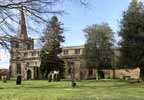For this church:    |
|
 Graffito
on south aisle pier Graffito
on south aisle pier |
Inside the church, the pier arcade of four bays is also built of sandstone. They are octagonal piers with double-chamfered arches. On the west side of the base-moulding of the eastern pier is graffito: Hic fuit Henricus Chilom.
The west wall is only roughly built of undressed sandstone, apparently as a temporary measure.
The tower was then added, using very large ashlared blocks of high quality Castle Donington or Weston upon Trent medium to coarse grained sandstone, with its eastern wall built close up to the west wall of the nave. There are two rectangular buttresses at NW and SE angles. The parapet is embattled. There is an octagonal spire, with a small light in each cardinal side. In all, the tower and spire measures 93 feet high.
The semi-circular stair turret at the NE angle of the tower is of sandstone, with an embattled parapet.
The porch, added in 1693, is of similar stone, perhaps from Gedling.
Some repair work here and there has been done using a harder Carboniferous, Millstone Grit Group sandstone with a pinkish hue, most likely from Birchover Quarry in Derbyshire.
Gill mentions “a square block of magnesian limestone, with a mason’s stop worked at each corner” – it has not been possible to confirm this although there is some limestone present there.






